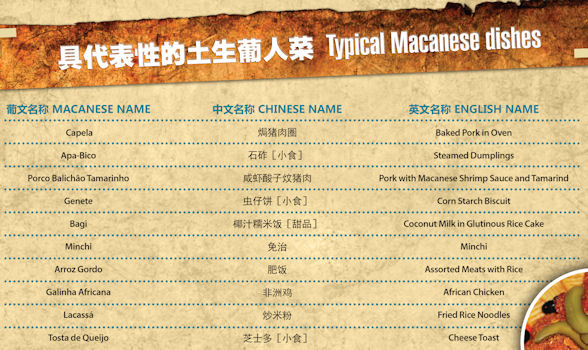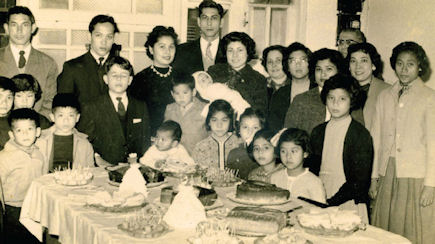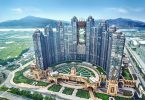This article first appeared in the Mar/Apr 2016 issue of WGM.
The Macanese are a special community in Macau, with a very unique culture. Their “Macanese Gastronomy” and “Patuá Theatre” are included on the Intangible Cultural Heritage List of Macau. At present, there are less than 50 people who can speak the Macanese Patuá language fluently and the number of Macanese people in Macau is only around 10,000. Even lots of Macau locals don’t have a full understanding of the Macanese community, while the younger generation has never heard of Macanese Patuá. To find out more, I visited Elisabela Larrea. An eighth generation Macanese, she directed the Macanese community documentary Sons of the Land, is working on a PhD in cross cultural studies at the University of Macau and has been carrying out “Quim sã nós? The Voice on the Postcolonial Stage: A study of Macanese Creole Theatre.” She spoke at length about this special culture and her hopes of ensuring its longevity.
![[b]A family photo of Elisabela Larrea when she was a child where you can see that she had already started eating Chinese food and using chopsticks; and(below) the wedding photo of Elisabela's grandparents. Her grandmother is Chinese.[/b]](http://www.wgm8.com/wp-content/uploads/2016/02/images_wgm_1040_mysteries-of-macanese-culture-1.jpg)
The varied definitions of “Macanese”
Lots of people ask: What exactly is Macanese? It is explained in The Taipa Houses Museum, which exhibits Macanese culture, as follows. Portugal is located in Europe’s Ibérian Peninsula, touching the North Atlantic Ocean on the west. During the period of geographical discovery, Portugal gradually developed into a colonial empire with territories across Europe, Asia and Africa.
After the navigator Vasco da Gama arrived in India and established a maritime route to the east, Portugal’s Jorge Alvares became the first European explorer to reach China by sea – paving the way for the Portuguese to settle in Macau in the 16th century. As a result, the next generation born in Macau were multi-racial children carrying different lineages such as Indian, Malay, Chinese, Japanese and so on.
The Macanese community slowly formed in Macau, however their views on what constitutes a Macanese vary greatly.

Many believe they are mixed blood. By observing the current characteristics of the Macanese, most are descendants of marriages between Portuguese and Malay. A small percentage are Indo-Portuguese descendants, while later on we also see a substantial increase in the number of Chinese-Portuguese descendants.
But they are not necessarily mixed blood. The children of Europeans or pure Portuguese after they settled in Macau are also considered Macanese. Some Chinese became Catholics in the 1930s and had Portuguese names, but they don’t actually have Portuguese lineage. Even they consider themselves Macanese.
People from different periods have different views on the definition of Macanese, mainly revolving around lineage, language, religion, self-identification, sense of belonging and so on. There still isn’t a clear consensus on the definition of “Macanese” among those who self-identify as such.
![[b]Elisabela Larrea is eighth generation Macanese[/b]](http://www.wgm8.com/wp-content/uploads/2016/02/images_wgm_1040_mysteries-of-macanese-culture-4.jpg)
“Portuguese Chicken” isn’t a Portuguese dish
“When the World Cup is on, the Macanese will definitely support the Portuguese team,” Larrea says, “but when asked where their home is, they will answer without hesitation: Macau.”
Larrea believes that the Macanese all consider Macau their home or hometown. Their life and culture are different to those Portuguese who call Portugal home. Even though they believe in the state religion of Portuguese Catholicism, they also believe in Feng Shui and numerology and comply with Chinese traditional customs, such as giving red packets (with gift money inside) during Chinese New Year. In terms of daily diet, they eat Portuguese, Chinese and cuisines of other countries. They even created “Macanese Gastronomy” from the mix of multiple ethnic cultures. She explains further, “On Christmas Eve, my Grandma will cook Chinese style chicken congee and fried noodles, western style turkey and roast lamb shanks as well as unique Macanese pastries such as Portuguese butter cake (Alua). We see food from different cultures on our dining table.”
“Macanese Gastronomy” is on the Intangible Cultural Heritage List of Macau. During the maritime trade period of the Portuguese, they drew on the diet and lifestyle of various races and cultures such as African, Indian and Malaysian. Another factor is that oriental spices are the main product of the Europe-Far East maritime trade. After they settled in Macau, a unique cuisine gradually formed based on the Portuguese cuisine and integrating various food cultures and ingredients – but we always confuse it with Portuguese cuisine.

“Macanese cuisine is in fact fusion food,” offers Larrea. “You can’t find it in Portugal – food such as Portuguese Chicken, African Chicken, Pork with Macanese Shrimp Sauce and so on. The Macanese dishes that Macanese families prepare differ a little bit according to their cultural backgrounds and flavor preferences, but the main ingredients are the same.”
Macanese Patuá desperate to survive
The Macau local dialect Macanese Patuá is another unique trait of the Macanese community. Because the Macanese people comprise multiple races, their language is based on Portuguese but mixed with Hindi, Malay, English, Spanish and Cantonese. It gradually evolved into a kind of language system, called Patuá. Larrea explained that, during the colonial period, you had to speak Portuguese to have a future, while Macanese Patuá was regarded as the “dialect of the countryside.” Speaking Patuá was regarded as uneducated. In order to strive for higher social status, those who spoke Macanese Patuá made sure the next generation learnt and spoke Portuguese. That’s why the abandoned Macanese Patuá is dying.
In 1987, China and Portugal signed the “Joint declaration of the Government of the People’s Republic of China and The Government of the Republic of Portugal on the question of Macao” – referred to as the Sino-Portuguese Joint Declaration. The declaration was an agreement that the Macau area (including Macau Peninsula, Taipa and Coloane) is Chinese territory. The Portuguese government handed over sovereignty to China on 20 December 1999.
“At this time, the Macanese community started thinking about their cultural heritage issue,” says Larrea. “In 1993, when Macau’s Patuá-language drama group, Dóci Papiaçám, was founded, the last Macanese writer Jose dos Santos Ferreira – who created his work using Macanese Patuá – passed away. This further stimulated the Macanese community’s desire to bring Macanese Patuá back into society.
![[b]Elisabela Larrea with her mother Laura Eusébio Larrea and her father Miguel Larrea[/b]](http://www.wgm8.com/wp-content/uploads/2016/02/images_wgm_1040_mysteries-of-macanese-culture-5.jpg)
“Since then, the Macanese spontaneously record their native dialects spoken by older generations and hold Patuá drama performances during the annual Macau Arts Festival.
“But the number of people who can speak Macanese Patuá fluently is less than 50 – and most of them are old. There are also a few people who can understand it but not speak it. Most can only use a few words and sentences.”
Macanese cuisine and the Patuá language are the two largest cultural products of the Macanese community in Macau. If you want to further understand their culture, we recommend the movie The Bewitching Braid. The movie was released in 1995 and written by Macanese lawyer and writer Henrique de Senna Fernandes. The Bewitching Braid will take you to Macau in the 1930s and presents a true reflection of transracial marriage stories of the Portuguese and Chinese in Macau at the time. For a more modern take, try the Macanese community documentary Sons of the Land (https://youtu.be/wI9osSzbnvA) directed by Elisabela Larrea. You may also listen to the music the Macanese are all familiar with (https://www.youtube.com/watch?v=JmPYVbKWF70). It is a great way to witness the rich cultural deposits of this small community.








This article was really interesting, thank you!
This is so interesting. I was so oblivious to that fact that there was a whole community of Chinese/Portuguese people like me.
Thank you for sharing this 🙂